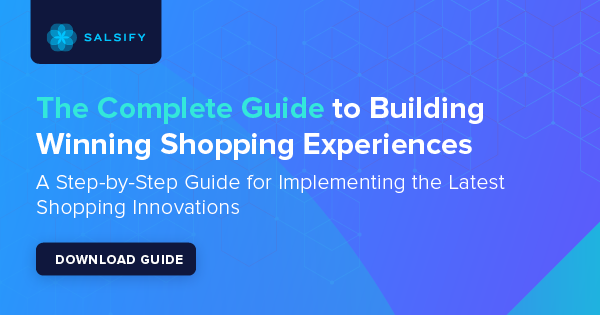

The Complete Guide to Building Winning Shopping Experiences
Download the guide to learn more about creating a customer-focused approach to your shopping experiences.
PIM
Manage all product content in one central system of record.
Syndication
Easily syndicate product content to every consumer touch point.
Enhanced Content
Enrich product pages with below-the-fold content and rich media.
Intelligence Suite
Bring AI-powered capabilities directly into your Salsify workflows.
Grocery Accelerator
Leverage the first-ever category-wide PXM accelerator in the grocery industry.
GDSN Data Pool
Synchronize standard supply chain, marketing, and ecommerce attributes globally.
Digital Shelf Analytics
Continuously optimize your organization’s product content syndication.
Catalog Sites
Share secure, on-brand, and always up-to-date digital product catalogs.
Automation and AI
Automate business processes and enhance Salsify workflows with AI.
PXM Platform, Integrations, and APIs
Integrate the PXM platform with the rest of your enterprise systems architecture.
Supplier Onboarding
Accelerate supplier onboarding while ensuring your schema requirements are met.
Product Listing
Sell products faster with Product Listing.
Content Enrichment
Increase online conversions with Content Enrichment.
Automation
Save time and increase operational efficiency with retail automation.
SXM Platform, Integrations, and APIs
Integrate the SXM platform with the rest of your enterprise systems architecture.
Syndication Network
Automate how you exchange product content data to the digital shelf.
Enhanced Content Network
Turn product pages into product experiences with Enhanced Content.
Commerce Platform Integrations
Create winning product experiences everywhere shoppers are, including on owned sites.
GDSN Data Pool
Synchronize standard supply chain, marketing, and ecommerce attributes globally.
Open Catalog
Connect to the digital shelf faster with an open, standardized, and free product catalog.
Resources
Resource Library
Explore our ecommerce resources to get everything you need to win on the digital shelf.
Blog
Read our blog to get actionable insights for navigating changing markets and industry demands.
Webinars
Watch our on-demand ecommerce webinars to gain expert advice and tips from our community of industry leaders.
Customer Blog
Gain the latest tips, industry trends, and actionable ecommerce insights.
Knowledge Base
Investigate our knowledge base to build your Salsify skills and understanding.
API
Examine our comprehensive API and webhook guides to start working with Salsify quickly.

Download the report to get expert insights, consumer research, and top industry trends.

Typical ecommerce models rely on point-in-time revenue. Brands engage visitors, visitors consider products, and products are purchased by new customers. Once initial sales are complete, brands must find ways to keep buyers coming back if they want revenue to remain consistent.
Subscription-based ecommerce offers another approach. Rather than selling customers a single item or service, subscription models provide a steady revenue stream over a fixed period.
This market is rapidly expanding. Global ecommerce subscriptions grew from $119.4 billion in 2022 to $196.35 in 202, as noted by The Business Research Company.
Significant growth suggests an opportunity for ecommerce brands — if they can create a subscription model their customers want.
Here’s a look at ecommerce subscription basics, how the model works, examples of brands that are doing it well, and how companies can create their own subscription strategy.
Subscription models are commonplace. From historic examples, such as daily newspapers to more recent iterations like ongoing access to streaming video content, subscriptions have long been used to provide greater value for customers and stable revenue for companies.
These subscriptions also help cultivate loyalty. If brands live up to their promises about product or service quality, customers may choose to extend their subscription beyond the original end date.
Ecommerce subscriptions follow the same basic format. The difference is that instead of buying a subscription in-store or by submitting physical forms, subscriptions are purchased online using a desktop or mobile device. These subscriptions provide an agreed-upon number of products or sets of services over a fixed period, after which customers can choose to cancel subscriptions or renew.
Benefits of subscription models for customers include:
For brands, subscription models provide a source of steady, recurring revenue.
Ecommerce subscription models work by offering customers something they want, when they want it, and in a way that adds value to their lives.
There are three basic types of ecommerce subscription models: content, curated, and recurring.
Content-based models offer access. Customers pay a set fee each month for access to unique content, discounts on current products, early access to new products, or perks such as free gifts. In a content-based model, most subscription benefits are digital, but some of these benefits may be used to offset the cost of new products.
Curated subscription models are all about personalization. Also called the “box” model, this approach focuses on the delivery of products to customers on a fixed schedule. The products delivered vary based on user preferences. For example, there are now subscription services that deliver a new wristwatch every month or every quarter. The exact style of the watch is unknown to the customer until the box arrives, but it’s informed by a survey of product preferences when they sign up for the service.
Recurring subscriptions are often used for household products, personal care, or food. In this model, customers choose a delivery schedule for their products and pay each time these products are shipped. Meal kits are a popular example, as customers have a set number of kits delivered each week and get to choose what they want from a curated list of meal options.
Amazon is one of the best ecommerce subscription examples because it is the industry leader in recurring subscriptions. They were the first ecommerce company to offer a subscribe-and-save model, which lets users select the delivery frequency of products — anything from personal care items to garbage bags or bird seed. Customers get a discount on these items, making this model a great choice for products that see consistent use.
From a content perspective, Netflix is an obvious front-runner. Customers pay a set price each month for access to streaming video content, and new content is regularly added to make the subscription worthwhile. Despite its success, however, Netflix also serves as a cautionary tale; rising prices and competition from other streaming services have prompted a reduction in total memberships, according to Statista.
Subscription box service FabFitFun offers a look at the curated model in action. Customers can choose either annual or seasonal subscriptions — annual subscribers pay $219.99 upfront and get four boxes per year, along with early access to customize their boxes with new products. Seasonal subscribers, meanwhile, pay $59.99 per box. Customers can choose to select their own lifestyle items or have them curated by FabFitFun teams.
Building a successful subscription program starts with engagement. Brands need to ensure they’re connecting with prospective buyers — and converting them into customers — before they introduce subscription options. In practice, this means leaning into trends such as viral video marketing, social media shopping, and the use of augmented reality (AR) to provide a more immersive shopping experience.
Once customers are on board and have made their first purchase, brands can introduce subscription options. For example, customers buying multiples of an item might subscribe to regular deliveries for a discount or could be offered access to premium content, such as discounts on future purchases or the ability to earn points that can be redeemed for new products.
Finally, brands need tools capable of capturing and distributing relevant ecommerce data across the organization to facilitate the subscription process. This could include the ability to populate product data directly into form templates, in turn reducing the time required to create new subscription options.
Ecommerce subscription models make it possible for companies to create steady, recurring revenue streams that both keep customers coming back and set the stage for further growth. No matter the approach, however — content, curated, or recurring — the key to success is offering customers something they want at a price they can afford, and that keeps them coming back.

Download the guide to learn more about creating a customer-focused approach to your shopping experiences.
Doug Bonderud (he/him) is an award-winning writer with expertise in ecommerce, customer experience, and the human condition. His ability to create readable, relatable articles is second to none.
Standing out on the digital shelf starts with access to the latest industry content. Subscribe to Below the Fold, our monthly content newsletter, and join other commerce leaders.